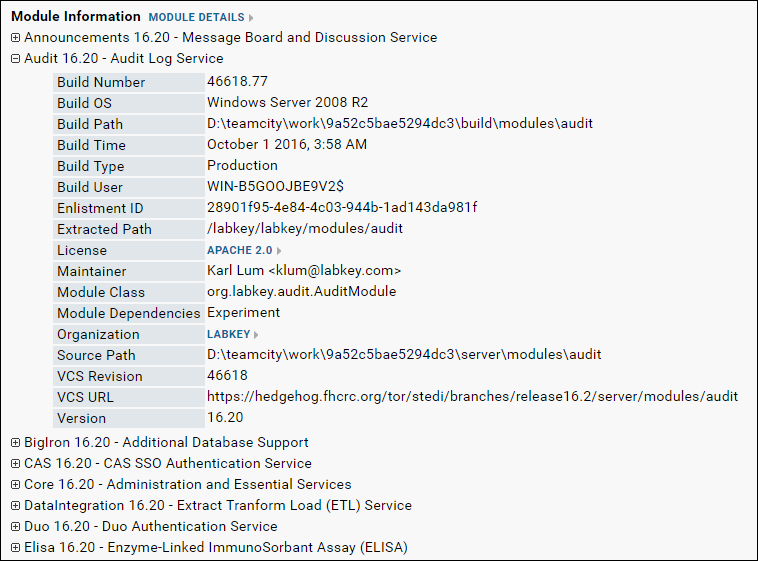myModule
│ module.properties
└───resources
├───...
├───...
└───...
Name: HelloWorld
ModuleClass: org.labkey.api.module.SimpleModule
Version: 1.0
ModuleClass: org.labkey.issue.IssuesModule
ModuleDependencies: Wiki, Experiment
Label: Issue Tracking Service
Description: The LabKey Issues module provides an issue tracker, a centralized workflow system for tracking issues or tasks across the lifespan of a project. Users can use the issue tracker to assign tasks to themselves or others, and follow the task through the work process from start to completion.
URL: https://www.labkey.org/wiki/home/Documentation/page.view?name=issues
Organization: LabKey
OrganizationURL: https://www.labkey.com/
License: Apache 2.0
LicenseURL: http://www.apache.org/licenses/LICENSE-2.0
| Property Name (in module.xml) | Property Name (in module.properties) | Description |
|---|---|---|
| class | ModuleClass | Main class for the module. For modules without Java code, use org.labkey.api.module.SimpleModule |
| name | Name | The display name for the module. |
| version | Version | The module version. |
| requiredServerVersion | RequiredServerVersionooo | The minimum required version for LabKey Server. |
| moduleDependencies | ModuleDependencies | A comma-delimited list of other module names this module depends upon. This determines module initialization order and controls the order in which SQL scripts run. For example, suppose your module includes a foreign key to a table in the Experiment module. In this case you could declare a dependency on the Experiment module, so that you can be sure that the target table exists before you try to create your foreign key. LabKey Server will give an error if you reference a module that doesn't exist, or if there's a circular dependency, for example, if ModuleA depends on ModuleB, which itself depends on ModuleA. |
| supportedDatabases | SupportedDatabases | Add this property to indicate that your module runs only on a particular database. Possible values: "pgsql" or "mssql". |
| label | Label | One line description of module's purpose (display capitalized and without a period at the end). |
| description | Description | Multi-line description of module. |
| url | URL | The homepage URL for additional information on the module. |
| author | Author | Comma separated list of names and, optionally, email addresses: e.g. "Adam Rauch <adamr@labkey.com>, Kevin Krouse" |
| maintainer | Maintainer | Comma separated list of names and, optionally, email addresses: e.g. "Adam Rauch <adamr@labkey.com>, Kevin Krouse" |
| organization | Organization | The organization responsible for the module. |
| organizationURL | OrganizationURL | The organization's URL/homepage. |
| license | License | License name: e.g. "Apache 2.0", "GPL-2.0", "MIT" |
| licenseURL | LicenseURL | License URL: e.g. "http://www.apache.org/licenses/LICENSE-2.0" |
| vcsRevision | VcsRevision | This value is set internally by the build, and does not need to be provided by the developer in module.properties. The SVN revision number of the module. This will be displayed next to the module in the site admin console. |
| vcsUrl | VcsURL | This value is set internally by the build, and does not need to be provided by the developer in module.properties. The URL to the SVN server that manages the source code for this module. This will be displayed next to the module in the site admin console. |
| buildOS | BuildOS | This value is set internally by the build, and does not need to be provided by the developer in module.properties. The operating system upon which the module was built. This will be displayed next to the module in the site admin console. |
| buildPath | BuildPath | This value is set internally by the build, and does not need to be provided by the developer in module.properties. The file path in which the module was built. This will be displayed next to the module in the site admin console. |
| buildTime | BuildTime | This value is set internally by the build, and does not need to be provided by the developer in module.properties. The date and time the module was built. This will be displayed next to the module in the site admin console. |
| buildType | BuildType | Possible values are "Development" or "Production". "Development" modules will not deploy on a production machine. To build modules destined for a production server, run 'ant production', or add the following to your module.properties file: 'BuildType=Production'. |
| buildUser | BuildUser | This value is set internally by the build, and does not need to be provided by the developer in module.properties. The name of the user that built the module. This will be displayed next to the module in the site admin console. |
| sourcePath | SourcePath | This value is set internally by the build, and does not need to be provided by the developer in module.properties. The location of the module source code. |
| resourcePath | ResourcePath | This value is set internally by the build, and does not need to be provided by the developer in module.properties. |
| buildNumber | BuildNumber | This value is set internally by the build, and does not need to be provided by the developer in module.properties. The build number. |
| enlistmentId | EnlistmentId | This value is set internally by the build, and does not need to be provided by the developer in module.properties. Used to determine whether the module was built on the current server. |
 The properties for deployed modules are available in the table core.Modules, where they can be accessed by the client API.
The properties for deployed modules are available in the table core.Modules, where they can be accessed by the client API.
<?xml version="1.0" encoding="UTF-8"?>
<beans xmlns="http://www.springframework.org/schema/beans"
xmlns:xsi="http://www.w3.org/2001/XMLSchema-instance"
xmlns:util="http://www.springframework.org/schema/util"
xsi:schemaLocation="http://www.springframework.org/schema/beans http://www.springframework.org/schema/beans/spring-beans-2.0.xsd">
<bean id="moduleBean" class="org.labkey.api.module.SimpleModule">
<property name="name" value="mymodule"/>
<property name="version" value="0.0"/>
<property name="requiredServerVersion" value="0.0"/>
<property name="moduleDependencies" value="Wiki"/>
<property name="label" value="My Module"/>
<property name="description">
<value><![CDATA[My module helps users solves problems related to...]]></value>
</property>
<property name="url" value="https://www.mywebsite.com"/>
<property name="author">
<value><![CDATA[Jane Doe <janedoe@email.com>]]></value>
</property>
<property name="maintainer">
<value><![CDATA[John Doe <johndoe@email.com>]]></value>
</property>
<property name="organization" value="My Software Inc."/>
<property name="organizationUrl" value="https://www.my-software-inc.com/"/>
<property name="license" value="Apache 2.0"/>
<property name="licenseUrl" value="http://www.apache.org/licenses/LICENSE-2.0"/>
</bean>
</beans>